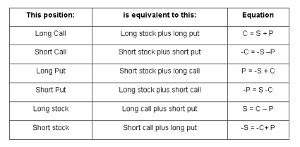Options instructor Russ Allen, of Online Trading Academy, outlines a general rule about options, that equivalent positions—also called synthetic positions—can be created for any component of a stock or option position.
In last week’s article, we pointed out how equivalent positions can be used to construct an options spread trade in an account where spreads were not allowed. We used long stock, a long put, and a covered call (all of which were available in that account) to create the equivalent of a bull call spread, which is not allowed. The point was to get access to something not formally offered in that type of account, in a way that is completely aboveboard and doesn’t violate any rules.
We saw there that owning a stock and buying a put option was equivalent to just buying a call option (with no stock). In fact, the stock-plus-put position could be called a synthetic long call.
Our approach there was a special case of a general rule about options, which is that equivalent positions, also called synthetic positions, can be created for any component of a stock or option position.
This is the basic equation: Cx = S + Px
Where Cx = the profit or loss on a call with strike price X
S = profit or loss on a Stock position
Px = profit or loss on a Put at strike price X
From last week’s example, the Cx we needed to create was the GLD call at the 107 strike price.
We synthesized it with 100 shares of stock, plus one put at the 107 strike. We showed that no matter where the price of GLD went, the stock-plus-put position would make or lose the same amount of money as the long call position.
We then added a short call at the 112 strike to give us an equivalent of a 107/112 Bull Call Spread.
Long calls are not the only things that can be synthesized. Rearranging the basic equation gives us these results:
Using these equivalents, we can create many kinds of option positions using combinations of the few basic ones we may be allowed. Here are some examples:
Note that both variations of the call spread above use the same components to make up the synthetic. What makes the position bullish or bearish is the selection of strikes X and Y. For a bull call spread we would usually select strikes X and Y so that X < stock price < Y. For a bear call spread it would be stock price < Y < X.
Again, both variations of the put spread use the same components and are differentiated by the strike prices. In both of the put spreads, we synthesize a short put at strike X using a lot (100 shares) of stock together with a short call at strike X. The short call is covered, since we own the stock, so it is allowed. The extra long put, at strike Y, is also allowed.
Options are like Lego blocks that we can assemble into different subassemblies for different purposes. Whenever there is a difficulty in buying or selling an option for some reason, we should always check for a synthetic solution. In many cases they are available and can allow us to do the trade that we want.
All of this assumes that we know what kinds of option positions we want in the first place.
By Russ Allen, Instructor, Online Trading Academy
























